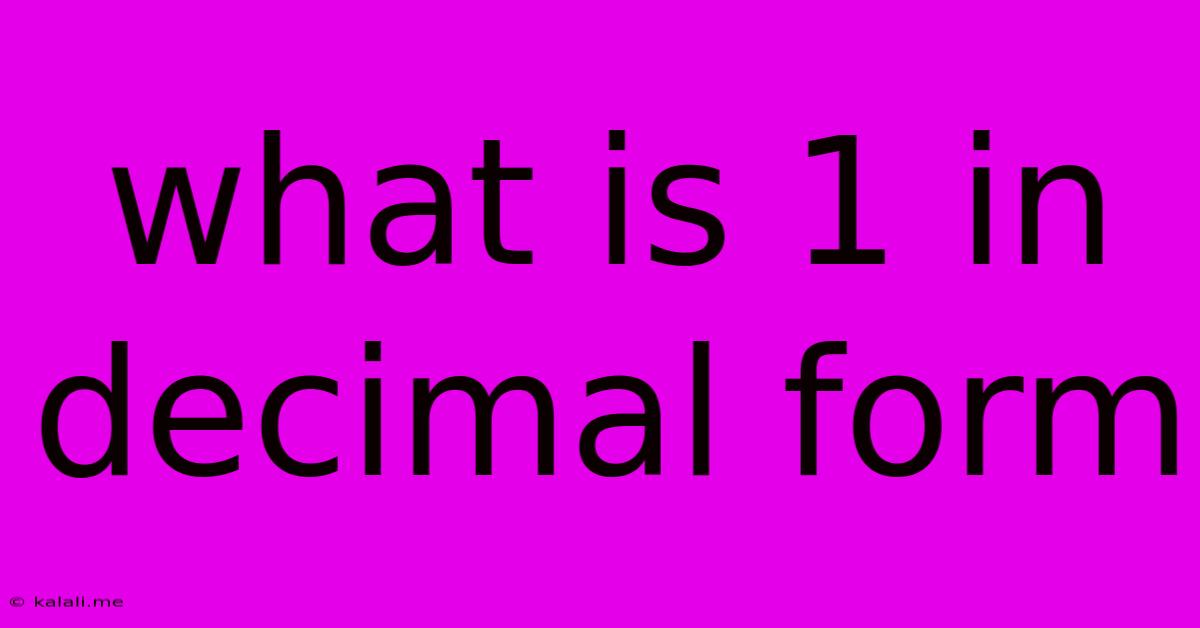What Is 1 In Decimal Form
Kalali
May 10, 2025 · 2 min read

Table of Contents
What is 1 in Decimal Form? A Simple Explanation
The number 1, in its simplest form, is already expressed in decimal form. The decimal system, also known as base-10, is the standard number system we use every day. It's based on powers of 10, using the digits 0 through 9 to represent values. Therefore, the number 1 is inherently a decimal number. This article will delve a little deeper into understanding this seemingly straightforward concept, exploring its representation and implications within the broader context of number systems.
Understanding the Decimal System
The decimal system is characterized by its place value system. Each position in a number represents a power of 10. For example:
- 10⁰ (Ones place): This is the rightmost digit, representing the number of ones.
- 10¹ (Tens place): The next position to the left represents the number of tens.
- 10² (Hundreds place): The position to the left of the tens place represents the number of hundreds.
- And so on...
The number 1, in decimal form, simply occupies the ones place. This means it represents one unit, or one whole. There are zero tens, zero hundreds, and so on.
1 Compared to Other Number Systems
While 1 remains 1 across different number systems, its representation can differ. For instance, in:
- Binary (base-2): 1 is represented as 1.
- Hexadecimal (base-16): 1 is still represented as 1.
- Octal (base-8): 1 remains 1.
This highlights the unique simplicity of the number 1; its value is consistent irrespective of the chosen base. However, the significance of '1' varies depending on its context, acting as a foundational element in mathematical operations and representing a single unit of quantity.
Applications of the Number 1
The number 1 plays a crucial role in various mathematical and computational contexts:
- Identity element: 1 is the multiplicative identity; any number multiplied by 1 remains unchanged.
- Counting: It's the fundamental unit in counting and represents a single object or entity.
- Programming: It represents the boolean value "true" in many programming languages.
- Fractions: It forms the basis for representing fractions, where 1 represents the whole.
In conclusion, while the question "What is 1 in decimal form?" might seem trivial, understanding its inherent nature within the decimal system provides a foundational understanding of numerical representation and its broader applications across various fields. Its simple representation belies its significant role in mathematics and computation.
Latest Posts
Latest Posts
-
In Many States Trailers With A Gvwr Of 1500
Jul 10, 2025
-
How Many Tablespoons Are In A Hidden Valley Ranch Packet
Jul 10, 2025
-
Which Is The Best Summary Of The Passage
Jul 10, 2025
-
How Many Quarts Of Soil In A Cubic Foot
Jul 10, 2025
-
What Is 3 4 Of A Pound
Jul 10, 2025
Related Post
Thank you for visiting our website which covers about What Is 1 In Decimal Form . We hope the information provided has been useful to you. Feel free to contact us if you have any questions or need further assistance. See you next time and don't miss to bookmark.